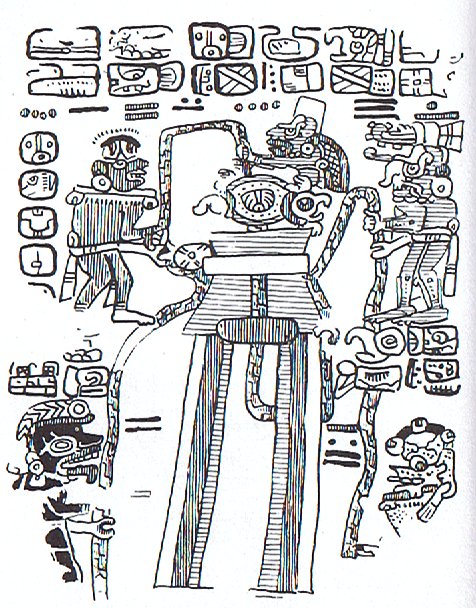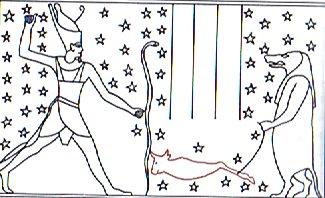|
TRANSLATIONS
The idea of joints ('elbows' and 'knees') being pictured pointing towards left to indicate the first half of a period and joints pointing towards right to indicate the second half agrees well with what we saw in Ea7-7--22:
Probably the sickles of waxing and waning moon have determined which way the joints should point - south of the equator waxing moon looks like this:
and also in the Mamari moon calendar the night glyphs are pictured the way waxing moon is looking as seen from Easter Island. I would now like to return to Rb1-105
which I imagine is showing us 'Saturn' (in bird reincarnation) cutting up the time into two pieces: past (henua at left) and future (henua at right). His attachment to the past is seen in his left (from us seen) foot being attached to the henua at left. His 'fists' probably depict the past year (left) and the new year (right) and he is sitting in the middle, i.e. in the X-area. The new year is holding the 'knife'. Metoro, I happened to notice, probably saw another such 'knife' (i.e. formed like the beak of a carrion bird) in the left (from us seen) 'wing' of this 'turtle' (Ab4-65)
because he said ko motumotu (and motumotu means 'to cut up', according to Churchill). This type of glyph (GD18, hônu) I have already earlier decided must have to do with winter solstice - a time when the sun is moving as slow as a turtle. Metoro's words at Ab4-65 tell us that this hônu is cutting up something, and probably it is the time that is being cut up. The turtle is a 'person' which also (e.g.) the Maya saw as located at the top of the year 'mound':
The picture - from Hamlet's Mill - is commented: "... the rope, the tortoise, and the churn (including an hourglass?) can be made out, and the 'kin', the sign of the sun, glides along the serpent-rope ..." Maybe Pa5-70 is a 'turtle'?
Although it is without 'arms' and 'legs' it anyhow belongs to GD18. If 'arms' and 'legs' stand for the quarters of the year, then it is reasonable to find a newborn turtle without such limbs. My intention is to present some more (introductory) facts and ideas about the 'persons' in the Egyptian picture of winter solstice:
But no turtle is to be seen. However, the 'serpent-rope' is central, and as midwinter is down in the 'water' I think this 'snake' must be a watery kind of creature. Allen: "Its [Hydra, the water-snake] representation has generally been as we have it, but the Hyginus of 1488 added a tree in whose branches the Hydra's head is resting; probably a recollection of the dragon that guarded the apple-trees of the Hesperides, although this duty really belonged to our Draco; and at times it has been shown as three-headed. Map-makers have always figured it in its present form, the Cup [a turtle shell?] resting midway on its back, with the Raven pecking at one of its folds; Hydra preventing the latter's access to the Cup in punishment for its tattling about Coronis, or for its delay in Apollo's service." "Hydra is supposed to be the snake shown on a uranographic stone from the Euphrates, of 1200 BC, 'identified with the source of the fountain of the great deep', and one of the several sky symbols of the great dragon Tiāmat." "Theon said that the Egyptians considered it the sky representative of the Nile, and gave it their name for that river." "After Al Sufi's day, in our 10th century, the figure was much lengthened, and now stretches for nearly 95º in a winding course from Cancer to Scorpio [both hard shell animals]; this well agreeing with the fable of its immense marine prototype, the Scandinavian Kraken. Conrad Gesner, the 16th century naturalist, gave an illustration of this in its apparently successful attack upon the ship Argo." "For an unknown period its winding course symbolized that of the moon; hence the latter's nodes are called the Dragon's Head and Tail. When a comet was in them poison was thought to be scattered by it over the world; but these fanciful ideas are now associated with Draco." "In China it [Alphard, α Hydrae] determined the 8th sieu, and was the prominent star of the Red Bird that combined the seven lunar divisions of the southern quarter of the heavens."
The 'Kraken' according to Wikipedia (artist: Pierre Dénys de Montfort) "There is a fish not yet mentioned which it is scarcely advisable to speak about on account of its size, which to most men will seem incredible. There are, moreover, but very few who can tell anything definite about it, inasmuch as it is rarely seen by men; for it almost never approaches the shore or appears where fishermen can see it, and I doubt that this sort of fish is very plentiful in the sea. In our language it is usually called the 'kra-ken'. I can say nothing definite as to its length in ells, for on those occasions when men have seen it, it has appeared more like an island than a fish. Nor have I heard that one has ever been caught or found dead. It seems likely that there are but two in all the ocean and that these beget no offspring, for I believe it is always the same ones that appear. Nor would it be well for other fishes if they were as numerous as the other whales, seeing that they are so immense and need so much food. It is said, that when these fishes Want something to eat, they are in the habit of giving forth a violent belch, which brings up so much food that all sorts of fish in the neighborhood, both large and small, will rush up in the hope of getting nourishment and good fare. Meanwhile the monster keeps it mouth open, and inasmuch as its opening is about as wide as a sound or fjord, the fishes cannot help crowding in great numbers. But as soon as its mouth and belly are full, the monster closes its mouth and thus catches and shuts in all the fishes that just previously had rushed in eagerly to seek food." (Wikipedia - 'The King's Mirror') |
||||||||||||||||||||||||||||||||||||||||||||||








